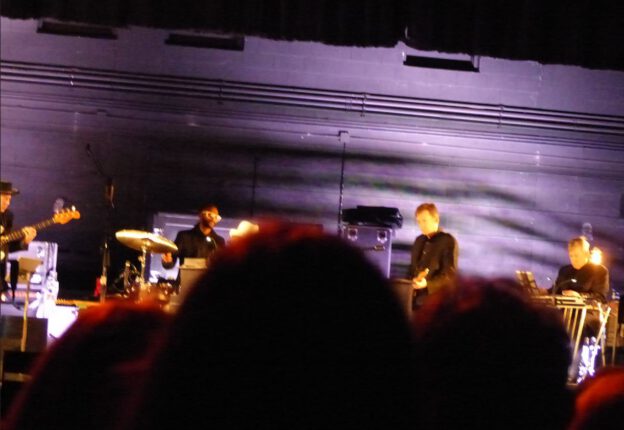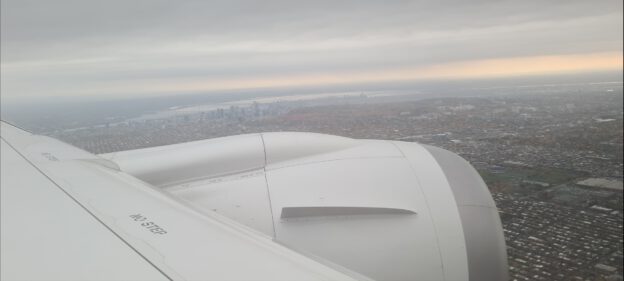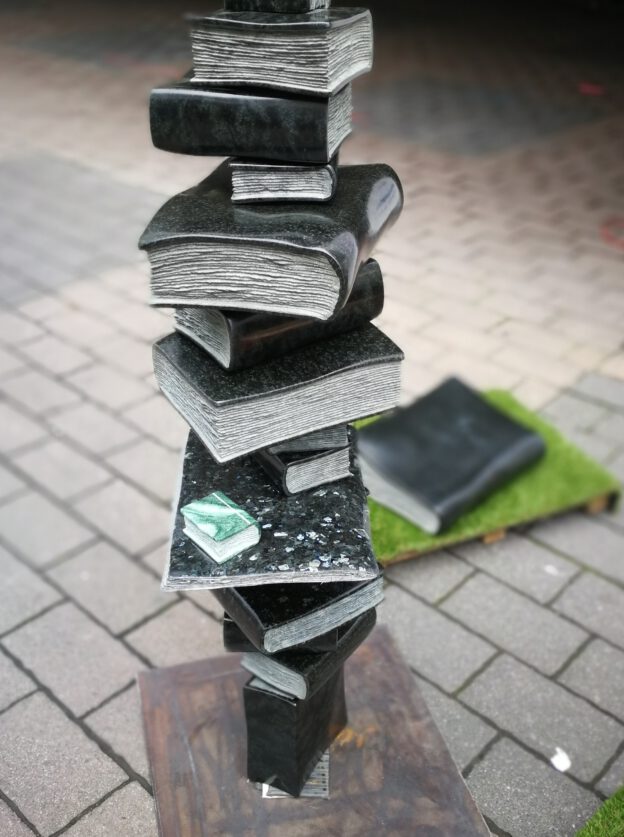photo by christof graf



photo by christof graf

photos by christof graf
Review/ Montreal, Quebec/ Place des Arts-Salle Wilfrid-Pelletier/ October 29, 2023
Review by Christof Graf
Bob Dylan pays tribute to Leonard Cohen in Montreal – „Dance Me To The End Of Love“
Bob Dylan’s profound homage to Leonard Cohen’s hometown of Montreal. This or something similar could be the headline of a concert review of yesterday’s concert at the sold-out Place des Arts-Salle Wilfrid-Pelletier in Montreal. And yes, the concert was one of the more profound, deepgoing and indeed a little different. The European performances on the „Rough And Rowdy Ways“ tour that I experienced in Europe were a bit different from yesterday’s Montreal concert. What has remained the same is the absolute ban on mobile devices and the strict admission controls.
Punctually at 8:00 p.m. local time, the classic intro sounds and the hall lights go out. Dylan’s band enters the stage. She plays the first notes of the opener „Watching The River Flow“. Perhaps it is due to the fact that it is my first Montreal concert by Bob Dylan that I am sensitized to new details in Dylan’s current concert format. Dylan enters the stage a moment later than the band. He sits down at the „Baby Grand Piano“ as usual, puts his white „Dandy Stetson“ hat on it and begins with the well-known lines „What’s the matter with me/ I don’t have much to say“. The Montreal audience, which is easy to inspire from the very first moment of the concert, rises for the first standing ovation of the evening. Dylan seems to acknowledge it benevolently with an immediate joy of playing. The first verses sound a bit untidy, but Bob and the band quickly find each other.
After „Most Likely You Go Your Way (and I’ll Go Mine)“, „I Contain Multitudes“ and „False Prophet“, the protagonists quickly turned the first third of the concert evening into a melodious melange of reminiscences of Dylan’s musical past with many „Shadow Kingdom arrangements“ at the latest with „When I Paint My Masterpiece“.
The stage design was positively surprising. In the summer, the stage in Europe was still bathed in a lot of dark blue, dark red and dark green light. In Montreal it was different. Dylan and the musicians stood on a brightly lit stage. For regular Dylan concertgoers, it was a welcome change to be able to recognize the faces of the performers. For those who sat in the front rows – I sat in the middle of the 14th row – it was almost a feast to be able to watch Dylan’s facial expressions. The stage itself also looked different compared to the European version in the summer. There was no longer a curtain in the background and no more large Hollywood movie spotlights that the musicians projected onto the stage in „shadows“. The „Oscar fake statue“ was also missing. For this purpose, there were four small light sources that looked like construction site lamps. They were ideally suited to give each musician so much light and space that their faces and the way they communicated with each other were recognizable even in the back rows.
The stage setup almost seemed like an untidy backyard, where six musician friends meet to jam and to grow a session from song to song into a concert to which they invited the neighborhood. The neighborhood that evening consisted of the 3000 Montrealers who were able to attend this concert, which began as a „session“ and became a sold-out concert. In the end, everyone experienced a small historical moment of glory on the „Rough And Rowdy Ways“ tour.
The band with Tony Garnier (electric and standup bass), Jerry Pentecost on drums, Bob Britt (acoustic guitar, electric guitar), Doug Lancio (acoustic guitar, electric guitar) and Donnie Herron (violin, electric mandolin, pedal steel, lap steel) was all dressed in black suits with black shirts, just like „His Bobness“.
On the sixth song „Black Rider“, the „master“ „broke through“ the black by putting on the white „Stetson“ and further developing the concert format with „My Own Version of You“, „I’ll Be Your Baby Tonight“ and „Crossing The Rubicon“. It was often the case that the songs started quietly and slowly and the band played their way into the songs until they developed a loud but never intrusive dynamic.
After „To Be Alone With You“ I listened to my favorites „Black Rider“ and „Crossing the Rubicon“, my next two favorites: „Key West“ and „Gotta Serve Somebody“. By then, Dylan had long since sung his way in and accentuated almost every line intelligibly. The audience consisted of three generations. It reacted again and again with small standing ovations, but quickly sat down again so as not to disturb the concert enjoyment of those sitting behind it. In addition, from song to song, it was an experience how Tony and Doug interacted with each other, how Bob communicated with Bob Britt with glances, and how Jerry and Donnie atmospherically condensed the band around the „Baby Grand Piano“.
Every now and then, Dylan would get up from the piano in the middle of the song, but quickly sit back down. He did not leave his position at the instrument during the entire concert. Gone are the days when he stepped to the edge of the stage for some songs, sang free-standing at the microphone stand or played the harmonica. Sitting is due to his age, but Bob Dylan still seems very vital in Montreal.
Most of the audience were not yet born at the time when Bob Dylan released his debut album 61 years ago. They weren’t even born when Bob Dylan played his first concert in Montreal on June 28, 1962 in front of just 15 people at what was then the PotPourri Club. Since then, he has traveled to the Canadian metropolis twenty times. Before his first concert after the pandemic yesterday, October 29, 2023, he performed at the Bell Centre on June 30, 2017.
His two appearances in 1975 and 1988 are legendary. Both refer to Montreal rock poet Leonard Cohen. Dylanians and Dylanologists, Cohen maniacs and Cohen lovers know about the anecdotes that outing Dylan and Cohen as „Brothers in Soul“. An earlier point of contact between Bob Dylan and Leonard Cohen dates back to 1975 and a meeting with Bob Dylan there. Bob Dylan played at Montreal’s Forum de Montréal on December 4 as part of his „Rolling Thunder Revue“ tour. There, Dylan made fun of Leonard Cohen’s immersion on the Greek island of Hydra. He dedicated the song „Isis“ to Cohen with the words: „This is for Leonhard, if he’s still here.“ In fact, Cohen was not on Hydra at the time, but, as Dylan knew, was in Montreal and even briefly backstage at Dylan’s invitation. Cohen met him and attended the concert, but not until the end. The statement „This Is For Leonard“ can be heard on the box set „The Rolling Thunder Revue: The 1975 Live Recordings“.
Dylan paid Cohen the greatest tribute when he sang Leonard Cohen’s „Hallelujah“ in two different concerts at the beginning of his „Never Ending Tour“ in 1988. Between „Stuck Inside Of Mobile With The Memphis Blues“ and „Ballad Of A Thin Man“, Dylan performed a Leonard Cohen song live in concert for the first time in his career on July 8, 1988 at the Forum de Montréal. An excerpt of a bootleg recording of it can be heard in the film „Hallelujah – A Song, A Journey“. Cohen himself has never interpreted a Bob Dylan song „Live in Concert“.
As a self-confessed Leonard Cohen fan, I was particularly excited about the Montreal concert in 2023. And of course I was aware that you should never have an expectation with Dylan, which is usually neither positively nor negatively fulfilled anyway. And why should they? However, the setlists of the „Rough And Rowdy Ways“ tour so far gave hope. Whereupon? On the fact that Bob Dylan may pay a musical homage to Leonard Cohen in Montreal. When Dylan goes on his concert tours to cities or areas where those close artists come from, he surprises them with cover songs. This was the case, for example, on October 16, 2023 in Indianapolis when Dylan interpreted John Mellencamp’s „Longest Days“.
And yes, something like that happened in Montreal yesterday again. After „That Old Black Magic“, Dylan stands up at the piano, looks at the audience with a smile on his lips and sings the first lines of Cohen’s song „Dance Me To The End Of Love“:
Dance me to your beauty with a burning violin
Dance me through the panic ‚til I’m gathered safely in
Lift me like an olive branch and be my homeward dove
Dance me to the end of love
The Montreal audience immediately recognizes the song and dares to let the next spontaneous standing ovation last a little longer. The song stands for the fact that everything will come to an end. Bob performs the waltz-like song in a very dylanesque way, without straying too far from the original. The audience is thrilled and downright grateful that Dylan pays this loving homage to his late former musical companion in his hometown. The song gives this 21st Montreal concert of Dylan a special touch, which once again reinforces the atmospheric density of the almost two-hour concert.
After „Mother of Muses“, Dylan introduces his backing musicians by name, then intones a loud and fast „Goodbye Jimmy Reed“ and a quiet „Every Grain of Sand“. Bob Dylan gets up from the piano, briefly enters the edge of the stage, looks into enthusiastic faces and leaves the stage. „Thanks For The Dance, Bob“ and for the fact that the fact that everything will come to an end one way or another can sound so wonderful.
Bob Dylan`s tiefgehende Hommage an Leonard Cohen`s Heimatstadt Montreal. So oder ähnlich könnte die Überschrift einer Konzertreview über das gestrige Konzert im ausverkauften Montrealer Place des Arts-Salle Wilfrid-Pelletier lauten. Und ja, das Konzert war eines der tiefgehenderen und in der Tat etwas anders. Die europäischen Performances auf der „Rough And Rowdy Ways“-Tour, die ich in Europa erleben durfte, unterschieden sich etwas vom gestrigen Montrealer Konzert. Was gleich geblieben ist, ist das absolute Mobile-Verbot und die strengen Einlasskontrollen.
Pünktlich um 20.00 Uhr Ortszeit erklingt das klassische Intro und die Saallichter gehen aus. Dylan`s Band betritt die Bühne. Sie spielt erste Töne des Openers „Watching The River Flow“. Vielleicht ist es der Tatsache geschuldet, daß es mein erstes Montreal-Konzert von Bob Dylan ist, daß ich für neue Details in Dylans aktuellem Konzertformat sensibilisiert bin. Dylan betritt einen Moment später als die Band die Bühne. Er setzt sich wie gewohnt ans „Baby Grand Piano“, legt seinen weißen „Dandy Stetson“-Hut darauf und beginnt mit den bekannten Zeilen „What’s the matter with me/ I don’t have much to say“. Das ab dem ersten Konzertmoment leicht zu begeisternde Montrealer Publikum erhebt sich schon allein dafür für eine erste Standing Ovation des Abends. Dylan scheint es wohlwollend mit sofort einsetzender Spielfreude zu quittieren. Die ersten Strophen klingen noch ein wenig unaufgeräumt, aber Bob und die Band finden schnell zueinander.
Nach „Most Likely You Go Your Way (and I’ll Go Mine)“, “I Contain Multitudes“ und „False Prophet“ haben die agierenden Protagonisten spätestens bei „When I Paint My Masterpiece“ das erste Drittel des Konzertabends schnell zu einer wohlklindenden Melange aus Reminiszenzen an Dylans musikalische Vergangenheit mit vielen „Shadow Kingdom-Arrangements“ gestaltet.
Positiv überraschend war das Bühnen-Design. Im Sommer war die Bühne in Europa noch in viel dunkelblauem, dunkelrotem und dunkelgrünen Licht eingetaucht. In Montreal war es anders. Dylan und die Musiker standen auf einer hell angeleuchteten Bühne. Für regelmäßige Dylan-Konzert-Besucher war es eine willkommene Abwechslung die Gesichter der Akteure erkennen zu können. Für jene, die in den vorderen Reihen sassen, – ich saß in der 14. Reihe mittig – , war es geradezu ein Fest, Dylans Mimik beobachten zu können. Auch die Bühne selbst, wirkte im Vergleich zur europäischen Variante im Sommer anders. Es gab keinen Vorhang im Hintergrund und keine großen Hollywood-Film-Scheinwerfer mehr, die die Musiker zu „Schatten“ auf die Bühne projizierten. Auch fehlte die „Oscar-Fake-Statue“. Dafür gab es vier kleine, wie Baustellen-Lampen wirkende Lichtquellen. Sie waren bestens dazu geeignet, jedem Musiker soviel Licht und Raum zu geben, daß auch deren Gesichter und die Art, wie sie miteinander kommunizierten auch bis in hintere Reihen erkennbar waren.
Fast wirkte der Bühnenaufbau, wie ein unaufgeräumter Hinterhof, auf dem sich sechs befreundete Musiker treffen, um zu jammen und um von Song zu Song eine Session zu einem Konzert wachsen zu lassen und zu dem sie die Nachbarschaft einluden. Die Nachbarschaft bestand an diesem Abend aus jenen 3000 Montrealern, die diesem als „Session“ begonnenen und zum ausverkauft gewordenem Konzert, beiwohnen konnten. Letztendlich erlebten alle eine kleine historische Sternstunde der „Rough And Rowdy Ways“-Tour.
Die Band mit Tony Garnier (electric and standup bass), Jerry Pentecost am Schlagzeug, Bob Britt (acoustic guitar, electric guitar), Doug Lancio (acoustic guitar, electric guitar) und Donnie Herron ( violin, electric mandolin, pedal steel, lap steel) war ausnahmslos wie auch „His Bobness“ in schwarzen Anzügen mit schwarzen Hemden gekleidet.
Beim sechsten Song „Black Rider“ „durchbrach“ der „Meister“ das Schwarz, in dem er sich den weissen „Stetson“ aufsetzte und mit „My Own Version of You“, „I`ll Be Your Baby Tonight“ und „Crossing The Rubicon“ das Konzertformat weiter entwickelte. Oft war es so, daß die Songs leise und langsam begannen und sich die Band in die Songs hineinspielte, bis sie eine laute aber nie aufdringliche Dynamik entwickelten.
Nach „To Be Alone With You“ hörte ich nach meinen bereits gehörten Favouriten „Black Rider“ und „Crossing the Rubicon“, meine nächsten beiden Favoriten: „Key West“ und „Gotta Serve Somebody“. Dylan hatte sich bis dahin längst eingesungen und akzentuierte fast jede Zeile verständlich. Das Publikum bestand aus drei Generationen. Es reagierte immer wieder mit kleinen Standing Ovations, setzte sich aber schnell wieder hin, um die dahinter sitzenden nicht am Konzertgenuss zu stören. Darüber hinaus war es von Song zu Song ein Erlebnis, wie Tony und Doug miteinander interagierten, wie Bob mit Bob Britt mit Blicken kommunizierten und wie Jerry und Donnie die Band rund um das „Baby Grand Piano“ atmosphärisch verdichteten.
Hin und wieder stand Dylan vom Piano mitten im Song auf, setzte sich aber schnell wieder hin. Seinen Standort am Instrument verließ er das gesamte Konzert nicht. Vorbei sind die Zeiten, als er für einige Songs zum Bühnenrand trat, am Mikrofonständer freistehend sang oder Mundharmonika spielte. Das Sitzen ist seinem Alter geschuldet, dennoch wirkt Bob Dylan in Montreal sehr vital.
Die meisten im Publikum waren zu jener Zeit, als Bob Dylan vor 61 Jahren sein Debutalbum veröffentlichte, noch nicht auf der Welt. Sie waren auch noch nicht auf der Welt, als Bob Dylan am 28. Juni 1962 für sein erstes Konzert in Montreal vor gerade einmal 15 Leuten im damaligen PotPourri Club auftrat. Seitdem bereiste er die kanadische Metropole zwanzig Mal. Vor seinem ersten Konzert nach der Pandemie am gestrigen 29. Oktober 2023 trat er am 30. Juni 2017 im Bell-Centre auf.
Legendär sind seine beiden Auftritte in den Jahren 1975 und 1988. Beide beziehen sich auf den Montrealer Rockpoeten Leonard Cohen. Dylanianer und Dylanologen, Cohen-Maniacs und Cohen-Lovers wissen um die Anekdoten, die Dylan und Cohen als „Brothers in Soul“ outen. Ein früherer Berührungspunkt Bob Dylans mit Leonard Cohen geht auf das Jahr 1975 und auf eine dortige Begegnung mit Bob Dylan zurück. Bob Dylan spielte im Rahmen seiner „Rolling Thunder Revue”-Tour am 4. Dezember im Montrealer „Forum de Montréal”. Dort machte sich Dylan über Leonard Cohens Versunkenheit auf der griechischen Insel Hydra lustig. Er widmete Cohen den Song „Isis” mit den Worten: „This is for Leonhard, if he’s still here.” Tatsächlich weilte Cohen zu der Zeit jedoch nicht auf Hydra, sondern war, wie Dylan wusste, in Montreal und sogar auf Einladung Dylans kurz Backstage. Cohen traf ihn und wohnte dem Konzert, jedoch nicht bis zum Schluss bei. Die Aussage „This Is For Leonard” ist auf dem Boxset „The Rolling Thunder Revue: The 1975 Live Recordings” zu hören.
Die größte Wertschätzung zollte Dylan Cohen, als er zu Beginn seiner „Never Ending Tour” im Jahr 1988 gleich in zwei verschiedenen Konzerten Leonard Cohen`s „Hallelujah” geradezu dylanesque anstimmte. Zwischen “Stuck Inside Of Mobile With The Memphis Blues” und “Ballad Of A Thin Man” trug Dylan am 8. Juli 1988 im „Forum de Montréal” erstmals einen Leonard Cohen-Song in seiner Karriere live in Concert vor. Ein Ausschnitt einer Bootleg-Aufnahme davon ist im Film „Hallelujah – A Song, A Journey” zu hören. Cohen selbst, hat nie einen Bob Dylan-Song „Live in Concert“ interpretiert.
Als bekennender Leonard Cohen-Fan war ich also auf das Montrealer Konzert 2023 besonders gespannt. Und natürlich war ich mir bewußt, daß man bei Dylan niemals eine Erwartungshaltung haben darf, die eh zumeist weder positiv noch negativ erfüllt wird. Warum auch? Die bisherigen Setlists der „Rough And Rowdy Ways“-Tour machten aber Hoffnung. Worauf? Darauf, daß Bob Dylan in Montreal Leonard Cohen womöglich eine musikalische Hommage erweisen wird. Wenn Dylan auf seinen Konzertreisen in Städte oder Gegenden kommt, aus denen jene nahestehenden Künstler stammen, überrascht er dort mit Cover-Songs. So war das z.B. am 16. Oktober 2023 in Indianapolis als Dylan John Mellencamp`s „Longest Days“ interpretierte.
Und ja, so etwas geschah dann auch in Montreal. Nach „That Old Black Magic“ steht Dylan am Piano auf, schaut mit einem Lächeln auf den Lippen ins Publikum und stimmt die ersten Zeilen von Cohens Song „Dance Me To The End Of Love“ an:
Dance me to your beauty with a burning violin
Dance me through the panic ‚til I’m gathered safely in
Lift me like an olive branch and be my homeward dove
Dance me to the end of love
Das Montrealer Publikum erkennt den Song sofort und wagt die nächste spontane Standing Ovation etwas länger dauern zu lassen. Der Song steht für die Tatsache, daß alles einmal ein Ende haben wird. Bob trägt den Walzerhaften-Song sehr dylanesque vor, ohne daß er sich zu weit vom Original entfernt. Das Publikum ist begeistert und ist geradezu dankbar, daß Dylan seinem einstigen musikalischen und 2016 verstorbenen Weggefährten in dessen Heimatstadt diese liebevolle Hommage erweist. Das Lied gibt diesem 21. Montrealer Konzert von Dylan eine besondere Note, die die atmosphärische Dichte des knapp zweistündigen Konzertes ein weiteres Mal verstärkt.
Nach „Mother of Muses“ stellt Dylan seine Begleitmusiker namentlich vor, intoniert danach, ein lautes und schnelles „Goodbye Jimmy Reed“ und ein leises „Every Grain of Sand“. Bob Dylan steht vom Piano auf, betritt kurz den Bühnenrand, schaut in begeisterte Gesichter und verläßt die Bühne. „Thanks For The Dance, Bob“ und dafür, daß die Tatsache, daß alles so oder so zu einem Ende führen wird, so wundervoll klingen kann.
Die Setlist:
| Montreal, Quebec Place des Arts-Salle Wilfrid-Pelletier October 29, 2023 |
| 1. | Watching The River Flow (Bob on baby grand piano) |
| 2. | Most Likely You Go Your Way (and I’ll Go Mine) (Bob on baby grand piano) |
| 3. | I Contain Multitudes (Bob on baby grand piano) |
| 4. | False Prophet (Bob on baby grand piano) |
| 5. | When I Paint My Masterpiece (Bob on baby grand piano) |
| 6. | Black Rider (Bob on baby grand piano) |
| 7. | My Own Version of You (Bob on baby grand piano) |
| 8. | I’ll Be Your Baby Tonight (Bob on baby grand piano) |
| 9. | Crossing The Rubicon (Bob on baby grand piano) |
| 10. | To Be Alone With You (Bob on baby grand piano) |
| 11. | Key West (Philosopher Pirate) (Bob on baby grand piano) |
| 12. | Gotta Serve Somebody (Bob on baby grand piano) |
| 13. | I’ve Made Up My Mind To Give Myself To You (Bob on baby grand piano) |
| 14. | That Old Black Magic (Bob on baby grand piano) |
| 15. | Dance Me To The End Of Love (Bob on baby grand piano) (song by Leonard Cohen) |
| 16. | Mother of Muses (Bob on baby grand piano) |
| — | Band introductions |
| 17 | Goodbye Jimmy Reed (Bob on baby grand piano) |
| 18. | Every Grain of Sand (Bob on baby grand piano and harp)
Bob Dylan – piano, harp |





photo: christof graf

 Autoren im Gespräch – Der Podcast zum Buch
Autoren im Gespräch – Der Podcast zum Buch(unten auf Pfeil klicken)
Das Buch:
Hydra, 1960: Der junge Leonard will ein berühmter Schriftsteller werden. Dann lernt er Marianne und ihren Mann kennen und wird Zeuge, wie ihre Ehe zerbricht. Leonard kümmert sich um die tief verletzte Marianne, sie verlieben sich ineinander. Nachdem sein Roman jedoch von der Kritik zerrissen wird, fällt Leonard in eine Depression. Jetzt ist es an Marianne, ihn zu retten: Sie schenkt ihm eine Gitarre und ermutigt Leonard dazu, Songs zu schreiben. Bald feiert er erste Erfolge. Doch kann Marianne ein Leben an der Seite eines Weltstars führen?
Ein berührender Roman über die unvergleichliche Liebe zwischen Marianne Ihlen und Leonard Cohen und die Geschichte hinter einem seiner berühmtesten Songs
Das Autorenpaar des Romans
Sylvia Frank ist das Pseudonym eines erfolgreichen deutschen Schriftstellerehepaares, das auf der Insel Rügen lebt. Sylvia Vandermeer, geboren 1968, ist habilitierte Betriebswirtschaftlerin. Sie studierte darüber hinaus Biologie, Psychologie und Bildende Kunst. Heute ist sie freiberuflich als Schriftstellerin und Malerin tätig. Frank Meierewert, geboren 1967, ist promovierter Ethnologe und seit 2016 als freier Autor tätig. Bei Rütten & Loening ist ihr Roman »Das Haus der Winde« über die große Schauspielerin Asta Nielsen erschienen, im Aufbau Taschenbuch liegt ihr Roman »Gala und Dalí – Die Unzertrennlichen« vor. Mehr Informationen unter https://sylviafrank.myportfolio.com/home

Die Pioniere der elektronischen Musik im Oktober 2023 auf großer Deutschland-Tour!
Nach ihrer UK & Irland Tour im März 2022 sind Tangerine Dream im Oktober 2023 zurück mit einer seit 2014 lang ersehnten großen Deutschland-Tournee. Mit dabei sind Tracks aus dem aktuellen Studioalbum „Raum“, „Los Santos City Map“ aus Grand Theft Auto V sowie die Klassiker „Phaedra“, „Love On A Real Train“ oder „White Eagle“, auch bekannt als „Das Mädchen auf der Treppe“, aus dem gleichnamigen Tatort. Das im Februar 2022 erschienene Album „Raum“, ist das zweite Studioalbum, das Thorsten Quaeschning, Hoshiko Yamane und Paul Frick seit dem Tod des Gründers Edgar Froese, aufgenommen haben. Es stieg auf Platz 39 in die deutschen Albumcharts und auf Platz 1 in die UK Dance Album Charts ein. „Raum“ markiert eine der erfolgreichsten Veröffentlichungen der Band und ist laut Pressestimmen „die beste Tangerine Dream Platte seit Jahrzehnten“ (Resident Advisor). Der Einfluss von Tangerine Dream auf die Entwicklung der elektronischen Musik ist enorm, mit einem riesigen Katalog an Alben, Live-Auftritten und Soundtracks. Im Jahr 2013 komponierten Tangerine Dream die Musik zu Rockstar’s Video Game Grand Theft Auto V, dem größten und erfolgreichsten Computerspiel der Welt. Edgar Froese gründete die Band 1967 und war seitdem das einzige konstante Mitglied der Gruppe bis zu seinem Tod im Jahr 2015. Jetzt besteht das Line-up aus Thorsten Quaeschning (seit 2005) als musikalischer Leiter, Hoshiko Yamane (seit 2011) und Paul Frick (seit 2020). Die Band ist wieder zum klassischen Sequenzer Sound zurückgekehrt und jeder Live-Auftritt endet mit einer sogenannten „Session“, einer Echtzeit-Komposition die im Anschluss an die klassischen Tracks in einem Konzert zwischen 30 bis 45 Minuten dauern kann.
Einlass: 19.00 Uhr